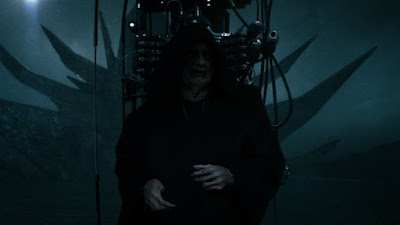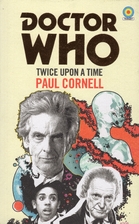Jingo: A Novel of Discworld by Terry Pratchett
People love genre mash-ups. Genre mash-ups are the entire way that Marvel has kept its film line vital.
Captain America: The First Avenger is superhero movie plus WWII film;
Thor is superhero movie plus epic fantasy;
Guardians of the Galaxy is superhero movie plus science fiction;
Ant-Man is superhero movie plus heist film; it seems to me that
Black Widow will be superhero movie plus espionage thriller.
But why is this? Is it just in that combining the tropes of two different familiar genres, something sufficiently new emerges as to be entertaining? I think that's part of it, but not all of it. Or, at least, not in the best cases. In the best cases, the writer is thinking through not just the
features of a genre, but its
project, and uses that to make some kind of commentary on one or both of the genres. Brian Michael Bendis and Michael Gaydos's
Alias (a.k.a.
Jessica Jones) is probably the gold standard of this for me: in combining superhero comics with noir, they use the powerlessness inherent in the noir genre to highlight the power fantasy inherent in the superhero genre. The stories of hopelessness told in
Alias were heightened by taking place in a world of gods. On the other hand, as much as I enjoyed Alan Moore and Gene Ha's
Top 10, I didn't feel like it really had anything to say via its combination of superheroics and police procedurals. It has good jokes, but it's mostly just the familiar beats of police procedurals with a veneer of superheroics on top: it's got all the
features of its two genres, but it doesn't really do anything with their
projects.
So what is Terry Pratchett doing in the City Watch books by combining heroic fantasy and police procedurals? Is he pulling an
Alias or a
Top 10? The dedication of the first City Watch novel,
Guards! Guards!, might suggest he's doing the latter:
They may be called the Palace Guard, the City Guard, or the Patrol. Whatever the name, their purpose in any work of heroic fantasy is identical: it is, round about Chapter Three (or ten minutes into the film) to rush into the room, attack the hero one at a time, and be slaughtered. No one ever asks them if they wanted to.
This book is dedicated to those fine men.
Ohoho, okay, it's funny to give the generic guards of fantasy stories actual lives.
But actually this dedication isn't very accurate: the City Watch of these novels never ends up in a situation remotely like the one the dedication describes! Despite the title of the first book, there's no point an evil tyrant ever does something like shout out "Guards! Guards!" as Boldnose, Son of Whomever saves the day. So why is this dedication actually here?
It points to the fact that heroic fantasy and police procedurals have very different attitudes toward the role of violence. In heroic fantasy, violence is authorized by the individual's own moral certainty, if not his Heroic Destiny, and operates outside the law. The hero does whatever he has to do to change the world because it is Right. In procedurals, on the other hand, the police deploy violence to restore the
status quo, which is the rule of law; their violence is only authorized inasmuch as it prevents crimes (i.e., violence not authorized by the state).
All of the City Watch novels in fact deal with this tension between political violence and what we might call regulatory violence. In
Guards! Guards!,
Men at Arms, and
Feet of Clay, there's criminal conspiracies and murders and such, but the
real crime is someone's attempt to place a true king on the throne of Ankh-Morpork. Attempts to remake the political structure of the land are the bread and butter of heroic fantasy-- indeed, the placing of a "true king" on the throne is usually how you know everything in your heroic fantasy adventure has Gone Right-- but are fundamentally illegal and immoral actions in a story about the rule of law. And in these stories, the villains are the people trying to restore the true king. (There are two interesting wrinkles about this, which I don't have time to go into here: Lord Vetinari, the patriarch of Ankh-Morpork, has no democratic legitimacy, he's just better than any alternatives, and there
is a real true king in the series who
could rule Ankh-Morpork
and would do so justly... and he's content to be a cop.)
So I bring all this up now (as opposed to in my reviews of the other City Watch books) because I think the conflict between regulatory violence and political violence reaches its peak in
Jingo. When a new piece of land is discovered in the sea between Ankh-Morpork and Klatch, both sides claim it posthaste. Soon, war fervor is beginning to sweep through Ankh-Morpork: Klatchians who have lived in the community for years start to come under suspicion and become the target of racist attacks. As xenophobia sweeps through society and as aristocrats prepare to line their own nests at the expense of the lower classes who will do the actual fighting and dying, Commander Vimes of the City Watch can do nothing but watch in frustration. Because it turns out that you can kill one man, and it's a crime-- but propel your nation into a war that will kill thousands, and it's
patriotism. It's weird to think that Pratchett wrote this in 1997, when there are so many obvious echoes of 9/11 in it; it's pretty discomforting to read it in 2019, a time once again of heightened xenophobia. Reading it, I shared in Vimes's sense of powerlessness and despair. People told me the Discworld books were funny. They didn't tell me they would be like
this!
The book's climax is amazing, and bears quoting at length. Vimes turns up just before the battle is due to begin, and attempts to arrest the head of the Klatchian army:
"Vimes, you have gone insane," said Rust [head of the Ankh-Morpork army]. "You can't arrest the commander of an army!"
"Actually, Mr. Vimes, I think we could," said Carrot. "And the army, too. I mean, I don't see why we can't. We could charge them with behavior likely to cause a breach of the peace, sir. I mean, that's what warfare is."
Vimes's face split in a manic grin. "I like it."
"But in fairness our—that is, the Ankh-Morpork army—are also—"
"Then you'd better arrest them, too," said Vimes. "Arrest the lot of 'em. Conspiracy to cause an affray," he started to count on his fingers, "going equipped to cause a crime, obstruction, threatening behavior, loitering with intent, loitering within tent, hah, traveling for the purposes of committing a crime, malicious lingering and carrying concealed weapons."
"I don't think that one—" Carrot began.
"I can't see 'em," said Vimes. (386-87)
It doesn't work, of course. The two armies do surrender (and Carrot reads them their rights!), but when one of Vimes's Klatchian allies asks what they're going to do
now, Vimes can only say, "I never thought we'd get this far!" (390) Soon Lord Vetinari shows up, ready with political machinations that he deploys to bring the war to an end.
But by God, it
ought to work that way, and that's what Pratchett taps into for four glorious pages. The detective story is,
Pam Bedore tells us, about contamination and containment: "The police procedural emphasizes the police detective's liminality rather than his conformity, as the police hero tends to function at the limits of the law, struggling to pursue justice within the bounds of his numerous rules and scarce resources" (29). As far as the rules are concerned, leading thousands to death in a war-- as the heroes of heroic fantasy do all the time-- is
perfectly legal. Vimes can arrest someone plotting the death of one other, but has no way to impose justice on someone plotting the deaths of thousands.
By bringing the police procedural into the heroic fantasy in
Jingo, Pratchett shows how war warps our very notions of justice, and twists good people into bad. You couldn't tell this story in an ordinary heroic fantasy story: you need the police procedural to expose the injustice of it all.
Plus it's very funny. Obviously the side-plot with Lord Vetinari, Sergeant Colon, and Nobby adventuring in Klatch is hilarious, but my favorite joke is probably this one:
"Veni, vidi, vici." I came, I saw, I conquered.
As a comment it always struck Vimes as a bit too pat. It wasn't the sort of thing you came up with on the spur of the moment, was it? It sounded as if he had worked it out. He'd probably spent long evenings in his tent, looking up in the dictionary short words beginning with V and trying them out... Veni, vermini, vomui, I came, I got ratted, I threw up? Visi, veneri, vamoosi, I visited, I caught an embarrassing disease, I ran away? It must have been a big relief to come up with three short acceptable words. He probably made them up first, and then went off to see somewhere and conquer it. (213)
And it's moving. The sub-plot about Vimes's organizer (
bingeley-bingeley beep!) starts off funny, but thanks to some timeline shenanigans, become quite a clever way to generate tension over a world that never came to be, but could have been quite significant, as you learn what kind of things could have happened there.
All of the City Watch novels are strong, but for me,
Jingo is the master class in plotting, themes, humor, and character. It all comes together perfectly.





























